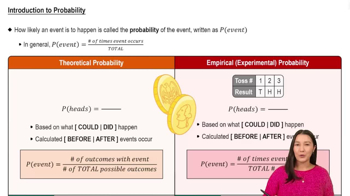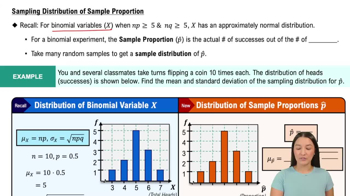Given the data below, determine the probability that a person randomly selected from Group 1 will be wearing jeans.
Table of contents
- 1. Intro to Stats and Collecting Data1h 14m
- 2. Describing Data with Tables and Graphs1h 55m
- 3. Describing Data Numerically2h 5m
- 4. Probability2h 16m
- 5. Binomial Distribution & Discrete Random Variables3h 6m
- 6. Normal Distribution and Continuous Random Variables2h 11m
- 7. Sampling Distributions & Confidence Intervals: Mean3h 23m
- Sampling Distribution of the Sample Mean and Central Limit Theorem19m
- Distribution of Sample Mean - Excel23m
- Introduction to Confidence Intervals15m
- Confidence Intervals for Population Mean1h 18m
- Determining the Minimum Sample Size Required12m
- Finding Probabilities and T Critical Values - Excel28m
- Confidence Intervals for Population Means - Excel25m
- 8. Sampling Distributions & Confidence Intervals: Proportion1h 25m
- 9. Hypothesis Testing for One Sample3h 29m
- 10. Hypothesis Testing for Two Samples4h 50m
- Two Proportions1h 13m
- Two Proportions Hypothesis Test - Excel28m
- Two Means - Unknown, Unequal Variance1h 3m
- Two Means - Unknown Variances Hypothesis Test - Excel12m
- Two Means - Unknown, Equal Variance15m
- Two Means - Unknown, Equal Variances Hypothesis Test - Excel9m
- Two Means - Known Variance12m
- Two Means - Sigma Known Hypothesis Test - Excel21m
- Two Means - Matched Pairs (Dependent Samples)42m
- Matched Pairs Hypothesis Test - Excel12m
- 11. Correlation1h 6m
- 12. Regression1h 50m
- 13. Chi-Square Tests & Goodness of Fit1h 57m
- 14. ANOVA1h 57m
4. Probability
Basic Concepts of Probability
Problem 4.1.24b
Textbook Question
In Exercises 21-28, find the probability and answer the questions.
Guessing Birthdays On their first date, Kelly asks Mike to guess the date of her birth, not including the year.
b. Would it be unlikely for him to guess correctly on his first try?
 Verified step by step guidance
Verified step by step guidance1
Step 1: Understand the problem. Kelly is asking Mike to guess her birth date (month and day) without including the year. There are 12 months in a year, and each month has a specific number of days. To calculate the probability, we need to determine the total number of possible dates in a year.
Step 2: Calculate the total number of possible dates. Assuming a non-leap year, there are 365 days in a year. Each day represents a unique combination of month and day. Therefore, the total number of possible dates is 365.
Step 3: Determine the probability of guessing correctly on the first try. Probability is calculated as the ratio of favorable outcomes to total outcomes. In this case, there is only 1 favorable outcome (guessing Kelly's exact birth date) out of 365 possible outcomes. The probability formula is: .
Step 4: Interpret the probability value. A probability of is very small, indicating that it is highly unlikely for Mike to guess correctly on his first try.
Step 5: Conclude the answer. Based on the calculated probability, it would indeed be unlikely for Mike to guess Kelly's birth date correctly on his first try.
 Verified video answer for a similar problem:
Verified video answer for a similar problem:This video solution was recommended by our tutors as helpful for the problem above
Video duration:
2mPlay a video:
Was this helpful?
Key Concepts
Here are the essential concepts you must grasp in order to answer the question correctly.
Probability
Probability is a measure of the likelihood that a particular event will occur, expressed as a number between 0 and 1. In the context of guessing a birthday, the probability of correctly guessing a specific date can be calculated by considering the total number of possible outcomes, which is typically 365 for a non-leap year. Thus, the probability of guessing correctly on the first try is 1/365, indicating a very low likelihood.
Recommended video:

Introduction to Probability
Sample Space
The sample space is the set of all possible outcomes of a random experiment. In this scenario, the sample space consists of all the days in a year, which is 365 days. Understanding the sample space is crucial for calculating probabilities, as it provides the basis for determining how many favorable outcomes exist compared to the total number of outcomes.
Recommended video:

Sampling Distribution of Sample Proportion
Unlikely Events
An event is considered unlikely if its probability is significantly low, often defined as less than 0.05 (or 5%). In the case of Mike guessing Kelly's birthday, with a probability of 1/365, this event falls well below the 5% threshold, making it unlikely for him to guess correctly on his first try. Recognizing unlikely events helps in understanding the nature of chance and randomness in probability.
Recommended video:

Probability of Multiple Independent Events

 5:37m
5:37mWatch next
Master Introduction to Probability with a bite sized video explanation from Patrick
Start learningRelated Videos
Related Practice
Multiple Choice
